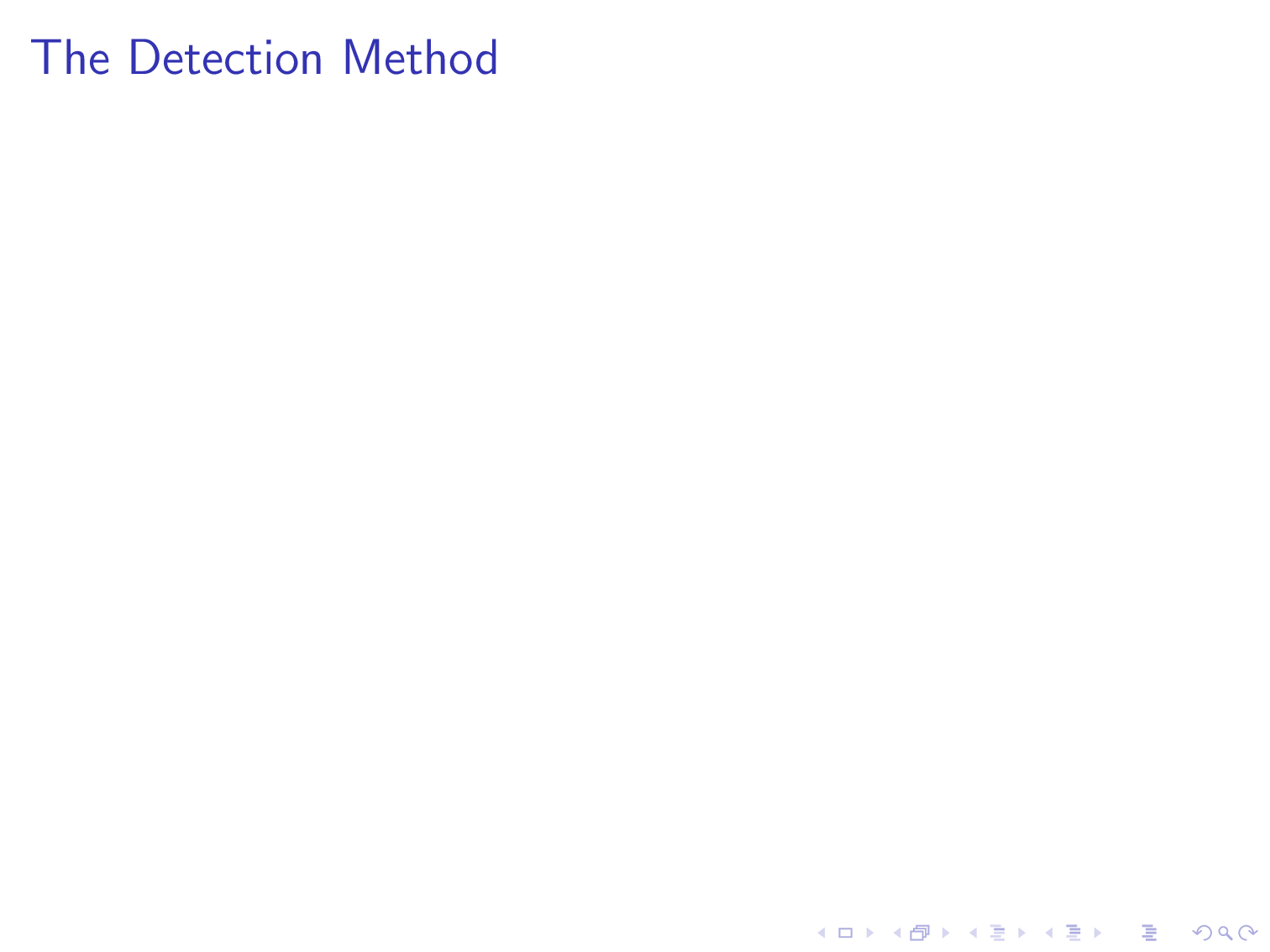
I am using Tikz to create a flow chart for a Beamer presentation. I managed to get Beamer to uncover each item in the flowshart one by one, but I would like to be able to show one node and then hide it. Is there any way to do this?
这是我的代码:
\begin{frame}{The Detection Method}
\tikzstyle{LargeBlock} = [rectangle, draw, fill=blue!20, text width=10em, text badly centered, rounded corners]
\tikzstyle{decision} = [diamond, draw, fill=red!20, text badly centered,text width=1.2cm]
\tikzstyle{block} = [rectangle, draw, fill=blue!20, text width=5em, text badly centered, rounded corners, minimum height=1em]
\tikzstyle{ImgBlock} = [rectangle, draw]
\tikzstyle{line} = [draw, -latex']
\tikzstyle{cloud} = [draw, ellipse,fill=red!20, minimum height=1em]
\tikzstyle{EmptyAnchor} = [ellipse,minimum height=1em]
\begin{tikzpicture}[node distance = 1cm, auto]
\pause{}
% Step 1
\node [LargeBlock, anchor=north] (init) {Simulated Planet + Star CCFs};\pause{}
% Step 2
\node [decision, right=1 cm of init] (build) {$\sum CCFs$};
\path [line] (init) -- (build); \pause{}
% Step 3
\node [block, below=0.5 cm of build] (template) {Star Template};
\path [line] (build) -- (template); \pause{}
% Step 4
\node [decision, below=0.5 cm of init] (normalise) {$\frac{CCFs}{Template}$};
\path [line] (init) -- (normalise);
\path [line] (template) -- (normalise); \pause{}
% Step
\node [EmptyAnchor, below=1.5 cm of normalise] (empty0) {};
\node [EmptyAnchor, right=2.5 cm of empty0] (empty3) {};
\node [ImgBlock, right=5 cm of empty0] (img1) {{\pgftext{\includegraphics[width=4.5cm,page=6]{./figures/Jupiter_3days_EELT.pdf}}}};
\path [line,dashed] (normalise) |- (empty3); \pause{}
% Step 5
\path [line] (init) -- (build);
\node [LargeBlock, below=0.5 cm of normalise] (NormCCFs) {Normalized CCFs};
\path [line] (normalise) -- (NormCCFs); \pause{}
% Step 6
\node [decision, below=0.5 cm of NormCCFs] (stack) {$stack$ $CCFs$};
\node [EmptyAnchor, below=0.5 cm of NormCCFs] (empty1) {};
\path [line] (NormCCFs) -- node[color=red]{Correct Planet RV} (stack); \pause{}
% Step 7
\node [EmptyAnchor, right=2 cm of stack] (empty2) {};
\node [ImgBlock, right=5 cm of empty1] (stop) {{\pgftext{\includegraphics[width=4.5cm,page=8]{./figures/Jupiter_3days_EELT.pdf}}}};
\path [line,dashed] (stack) -- (empty2);
\end{tikzpicture}
\end{frame}
我想要节点(图片1)当节点出现然后消失(规范 CCF)出現。
有谁愿意接受吗?
答案1
\node您可以利用和感知叠加的事实\path,这样您就可以在所需的幻灯片上显示元素:
\PassOptionsToPackage{demo}{graphicx}
\documentclass{beamer}
\usepackage{tikz}
\usetikzlibrary{shapes.geometric,positioning,arrows}
\begin{document}
\begin{frame}{The Detection Method}
\tikzstyle{LargeBlock} = [rectangle, draw, fill=blue!20, text width=10em, text badly centered, rounded corners]
\tikzstyle{decision} = [diamond, draw, fill=red!20, text badly centered,text width=1.2cm]
\tikzstyle{block} = [rectangle, draw, fill=blue!20, text width=5em, text badly centered, rounded corners, minimum height=1em]
\tikzstyle{ImgBlock} = [rectangle, draw]
\tikzstyle{line} = [draw, -latex']
\tikzstyle{cloud} = [draw, ellipse,fill=red!20, minimum height=1em]
\tikzstyle{EmptyAnchor} = [ellipse,minimum height=1em]
\begin{tikzpicture}[node distance = 1cm, auto]
\pause{}
% Step 1
\node [LargeBlock, anchor=north] (init) {Simulated Planet + Star CCFs};\pause{}
% Step 2
\node [decision, right=1 cm of init] (build) {$\sum CCFs$};
\path [line] (init) -- (build); \pause{}
% Step 3
\node [block, below=0.5 cm of build] (template) {Star Template};
\path [line] (build) -- (template); \pause{}
% Step 4
\node [decision, below=0.5 cm of init] (normalise) {$\frac{CCFs}{Template}$};
\path [line] (init) -- (normalise);
\path [line] (template) -- (normalise); \pause{}
% Step
\node [EmptyAnchor, below=1.5 cm of normalise] (empty0) {};
\node [EmptyAnchor, right=2.5 cm of empty0] (empty3) {};
\node<6> [ImgBlock, right=5 cm of empty0] (img1) {{\pgftext{\includegraphics[width=4.5cm,page=6]{./figures/Jupiter_3days_EELT.pdf}}}};
\path<6> [line,dashed] (normalise) |- (empty3); \pause{}
% Step 5
\path [line] (init) -- (build);
\node [LargeBlock, below=0.5 cm of normalise] (NormCCFs) {Normalized CCFs};
\path [line] (normalise) -- (NormCCFs); \pause{}
% Step 6
\node [decision, below=0.5 cm of NormCCFs] (stack) {$stack$ $CCFs$};
\node [EmptyAnchor, below=0.5 cm of NormCCFs] (empty1) {};
\path [line] (NormCCFs) -- node[color=red]{Correct Planet RV} (stack); \pause{}
% Step 7
\node [EmptyAnchor, right=2 cm of stack] (empty2) {};
\node [ImgBlock, right=5 cm of empty1] (stop) {{\pgftext{\includegraphics[width=4.5cm,page=8]{./figures/Jupiter_3days_EELT.pdf}}}};
\path [line,dashed] (stack) -- (empty2);
\end{tikzpicture}
\end{frame}
\end{document}

顺便说一句,利用 TikZ 命令具有覆盖感知的事实,或者使用\onslide<>{...}或者\only<...>{}您可以获得比使用简单\pause命令更好的控制(如果需要)。
这是现在的代码,但使用\onslide规范;我还用新的 \tikzset 语法替换了旧的 \tikzstyle 语法:
\PassOptionsToPackage{demo}{graphicx}
\documentclass{beamer}
\usepackage{tikz}
\usetikzlibrary{shapes.geometric,positioning,arrows}
\begin{document}
\begin{frame}{The Detection Method}
\tikzset{
LargeBlock/.style={rectangle, draw, fill=blue!20, text width=10em, text badly centered, rounded corners},
decision/.style = {diamond, draw, fill=red!20, text badly centered,text width=1.2cm},
block/.style = {rectangle, draw, fill=blue!20, text width=5em, text badly centered, rounded corners, minimum height=1em},
ImgBlock/.style = {rectangle, draw},
line/.style = {draw, -latex'},
cloud/.style = {draw, ellipse,fill=red!20, minimum height=1em},
EmptyAnchor/.style = {ellipse,minimum height=1em}
}
\begin{tikzpicture}[node distance = 1cm, auto]
% Step 1
\node [LargeBlock, anchor=north] (init) {Simulated Planet + Star CCFs};\pause{}
% Step 2
\onslide<+->{\node [decision, right=1 cm of init] (build) {$\sum CCFs$};
\path [line] (init) -- (build);
}
% Step 3
\onslide<+->{\node [block, below=0.5 cm of build] (template) {Star Template};
\path [line] (build) -- (template);
}
% Step 4
\onslide<+->{\node [decision, below=0.5 cm of init] (normalise) {$\frac{CCFs}{Template}$};
\path [line] (init) -- (normalise);
\path [line] (template) -- (normalise);
}
\onslide<+->{\node [EmptyAnchor, below=1.5 cm of normalise] (empty0) {};
\node [EmptyAnchor, right=2.5 cm of empty0] (empty3) {};
}
\onslide<+>{\node [ImgBlock, right=5 cm of empty0] (img1) {{\pgftext{\includegraphics[width=4.5cm,page=6]{./figures/Jupiter_3days_EELT.pdf}}}};
\path [line,dashed] (normalise) |- (empty3);
}
% Step 5
\onslide<+->{\path [line] (init) -- (build);
\node [LargeBlock, below=0.5 cm of normalise] (NormCCFs) {Normalized CCFs};
\path [line] (normalise) -- (NormCCFs);
}
% Step 6
\onslide<+->{\node [decision, below=0.5 cm of NormCCFs] (stack) {$stack$ $CCFs$};
\node [EmptyAnchor, below=0.5 cm of NormCCFs] (empty1) {};
\path [line] (NormCCFs) -- node[color=red]{Correct Planet RV} (stack);
}
% Step 7
\onslide<+->{\node [EmptyAnchor, right=2 cm of stack] (empty2) {};
\node [ImgBlock, right=5 cm of empty1] (stop) {{\pgftext{\includegraphics[width=4.5cm,page=8]{./figures/Jupiter_3days_EELT.pdf}}}};
\path [line,dashed] (stack) -- (empty2);
}
\end{tikzpicture}
\end{frame}
\end{document}
线路
\PassOptionsToPackage{demo}{graphicx}
只需用黑色矩形替换实际图像即可。不是在实际代码中使用该行。


